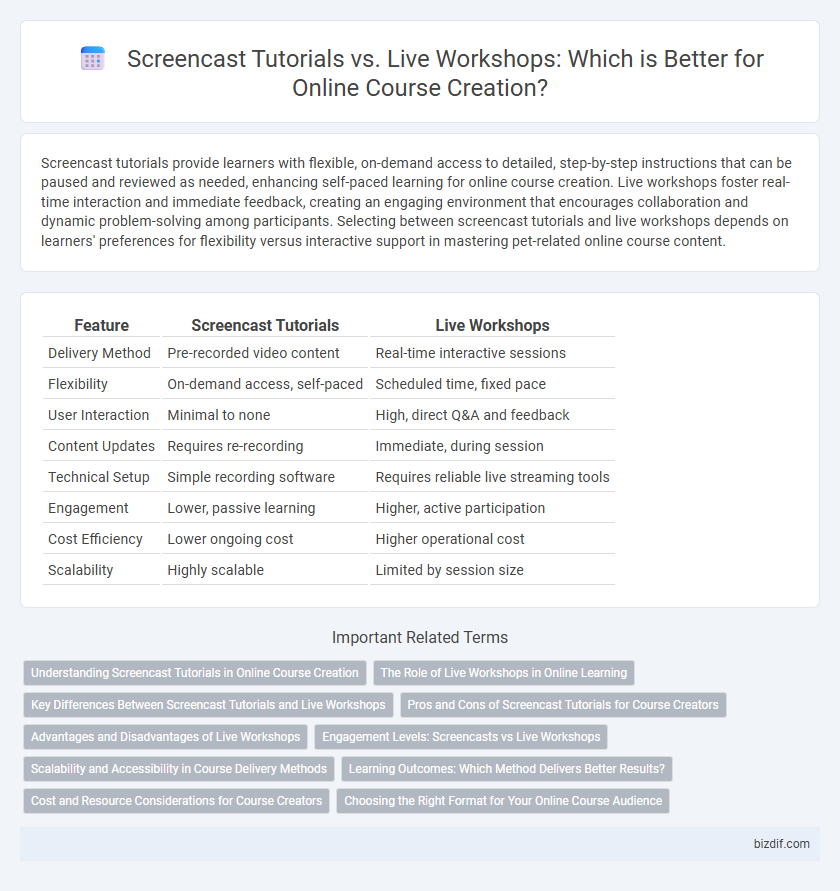Screencast tutorials provide learners with flexible, on-demand access to detailed, step-by-step instructions that can be paused and reviewed as needed, enhancing self-paced learning for online course creation. Live workshops foster real-time interaction and immediate feedback, creating an engaging environment that encourages collaboration and dynamic problem-solving among participants. Selecting between screencast tutorials and live workshops depends on learners' preferences for flexibility versus interactive support in mastering pet-related online course content.
Table of Comparison
| Feature | Screencast Tutorials | Live Workshops |
|---|---|---|
| Delivery Method | Pre-recorded video content | Real-time interactive sessions |
| Flexibility | On-demand access, self-paced | Scheduled time, fixed pace |
| User Interaction | Minimal to none | High, direct Q&A and feedback |
| Content Updates | Requires re-recording | Immediate, during session |
| Technical Setup | Simple recording software | Requires reliable live streaming tools |
| Engagement | Lower, passive learning | Higher, active participation |
| Cost Efficiency | Lower ongoing cost | Higher operational cost |
| Scalability | Highly scalable | Limited by session size |
Understanding Screencast Tutorials in Online Course Creation
Screencast tutorials in online course creation offer a flexible, self-paced learning experience by providing recorded video demonstrations that clearly showcase software usage or step-by-step processes. These tutorials enable learners to pause, rewind, and review complex concepts at their convenience, enhancing comprehension and retention. Compared to live workshops, screencasts deliver consistent content quality and accessibility, making them ideal for scalable, on-demand education.
The Role of Live Workshops in Online Learning
Live workshops play a crucial role in online learning by fostering real-time interaction, immediate feedback, and collaborative problem-solving among participants. Unlike screencast tutorials, which offer pre-recorded, static content, live workshops create dynamic environments that enhance learner engagement and adaptability. This interactive format helps deepen understanding, build community, and address diverse learning needs more effectively.
Key Differences Between Screencast Tutorials and Live Workshops
Screencast tutorials offer on-demand access with pre-recorded content, allowing learners to pause and revisit material at their own pace, while live workshops provide real-time interaction, fostering immediate feedback and dynamic discussions. Screencasts emphasize technical demonstration with consistent delivery, whereas live workshops adapt to participant questions and engagement levels for a more personalized experience. The choice between these formats impacts learner engagement, content flexibility, and instructor involvement in online course creation.
Pros and Cons of Screencast Tutorials for Course Creators
Screencast tutorials offer course creators the advantage of producing high-quality, reusable content that learners can access anytime, enhancing flexibility and scalability. These recorded sessions minimize technical glitches and allow detailed editing, but often lack real-time interaction and immediate feedback that live workshops provide. However, the asynchronous nature of screencasts may reduce engagement and limit opportunities for spontaneous learner questions and community building.
Advantages and Disadvantages of Live Workshops
Live workshops offer real-time interaction, enabling immediate feedback and personalized guidance, which enhances learner engagement and retention. However, they require scheduling coordination, which can limit accessibility for global participants and increase logistical complexity. The dynamic nature of live sessions may also pose challenges for consistency and scalability compared to pre-recorded screencast tutorials.
Engagement Levels: Screencasts vs Live Workshops
Screencast tutorials offer consistent, on-demand content allowing learners to progress at their own pace, but they often lack real-time interaction, which can reduce engagement. Live workshops foster higher engagement levels by enabling immediate feedback, dynamic discussions, and active participation, creating a more immersive learning experience. Online course creators must balance scalability and personalized engagement when choosing between screencasts and live workshop formats.
Scalability and Accessibility in Course Delivery Methods
Screencast tutorials offer superior scalability by allowing unlimited learners to access content asynchronously, enhancing global reach without increasing instructor workload. Live workshops provide real-time interaction and immediate feedback but are limited in scalability due to scheduling constraints and participant capacity. Accessibility improves with screencasts as learners can engage at their own pace and revisit material, while live sessions depend on fixed times and require stable internet connections for optimal participation.
Learning Outcomes: Which Method Delivers Better Results?
Screencast tutorials provide learners with the flexibility to revisit complex topics at their own pace, enhancing retention and mastery of material. Live workshops foster real-time interaction and immediate feedback, which significantly boosts engagement and practical application of skills. Studies indicate that combining both methods maximizes learning outcomes by balancing self-paced review with dynamic, hands-on experiences.
Cost and Resource Considerations for Course Creators
Screencast tutorials offer a cost-effective solution for online course creation by requiring minimal equipment such as screen recording software and a quality microphone, reducing expenses associated with live production. Live workshops demand higher resource investment, including reliable streaming platforms, bandwidth, and scheduling coordination, which can increase overhead and time commitment. Course creators must balance initial setup costs against scalability and engagement goals when choosing between these formats.
Choosing the Right Format for Your Online Course Audience
Screencast tutorials offer a scalable, self-paced learning experience ideal for audiences seeking flexibility and repeatable content, leveraging clear visuals and step-by-step instructions to enhance understanding. Live workshops foster real-time interaction, personalized feedback, and community building, which benefits learners who thrive on engagement and direct support. Assessing your audience's preferences, learning goals, and technical capabilities is crucial for selecting the format that maximizes retention and course satisfaction.
Screencast tutorials vs Live workshops Infographic

 bizdif.com
bizdif.com